The ideal therapy duration for diabetic sores usually falls between 12 to 42 days, depending on factors like the type of ulcer and how well treatments work. For example, with advanced therapies like Apligraf, you might see significant healing in around 42 days. If the sore reduces by 50% in four weeks, that's a positive sign. However, only 24% of diabetic ulcers heal after 12 weeks of good care, emphasizing the need for ongoing evaluation. To better understand how to manage and potentially speed up healing, there's more to explore on this topic.
Understanding Diabetic Sores
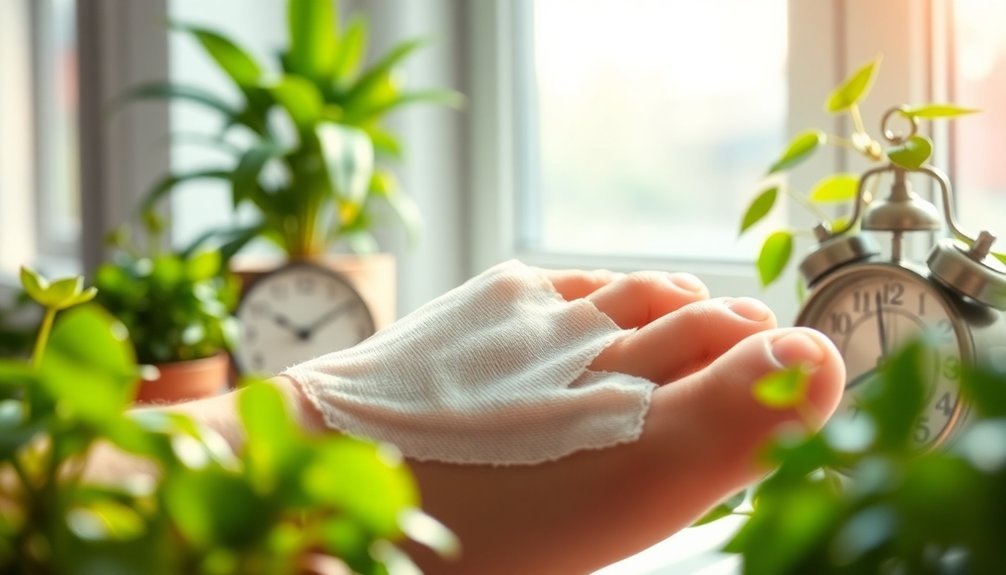
Diabetic sores, often referred to as diabetic foot ulcers, can develop due to a combination of factors stemming from uncontrolled blood sugar levels. High glucose levels stiffen arteries and narrow blood vessels, limiting blood and oxygen delivery, which are essential for healing. This can increase your risk of peripheral arterial disease (PAD) and severely impair your body's natural healing abilities.
Poor circulation further complicates matters; it hampers blood flow to your feet and legs, making chronic wounds even harder to heal. If left untreated, this may lead to amputation.
Uncontrolled blood sugar can also cause nerve damage, resulting in a loss of sensation. You mightn't notice small cuts or blisters, which can quickly escalate into ulcers. Additionally, 14-24% of ulcer patients may face amputation if prompt treatment isn't sought.
If your immune system is struggling, it takes longer to fight off infections and clear damaged tissue, which further delays recovery.
These factors combined create an elevated risk for developing diabetic sores. Understanding these elements is critical not only for prevention but also for effective treatment strategies, so you can work closely with healthcare providers to manage your condition proactively.
Typical Healing Rates
Healing rates for diabetic sores vary considerably based on the type of care received. If you're monitoring an ulcer, keep a close eye on its reduction in size within the first four weeks. A significant indicator of healing is a 50% area reduction during this period.
Patients achieving more than a 53% reduction have a 58% chance of healing within 12 weeks. Unfortunately, if the ulcer area decreases by less than this median, only about 9% of those will heal.
In terms of healing duration, roughly 24% of diabetic neuropathic ulcers heal after 12 weeks of good care, whereas this number increases to 31% after 20 weeks. Moreover, the application of biological therapy is shown to enhance the healing rate, leading to higher success for patients with diabetic ulcers.
If you opt for advanced therapies like Apligraf, the results are often dramatically better. You can expect an 86% healing rate in an average of just 42 days with this treatment.
In contrast, wounds treated with standard care can take longer; many may not heal within three months. Regularly evaluating your wound's progress is essential, as it informs whether you need to adjust your treatment strategy to enhance healing prospects.
Factors Affecting Healing
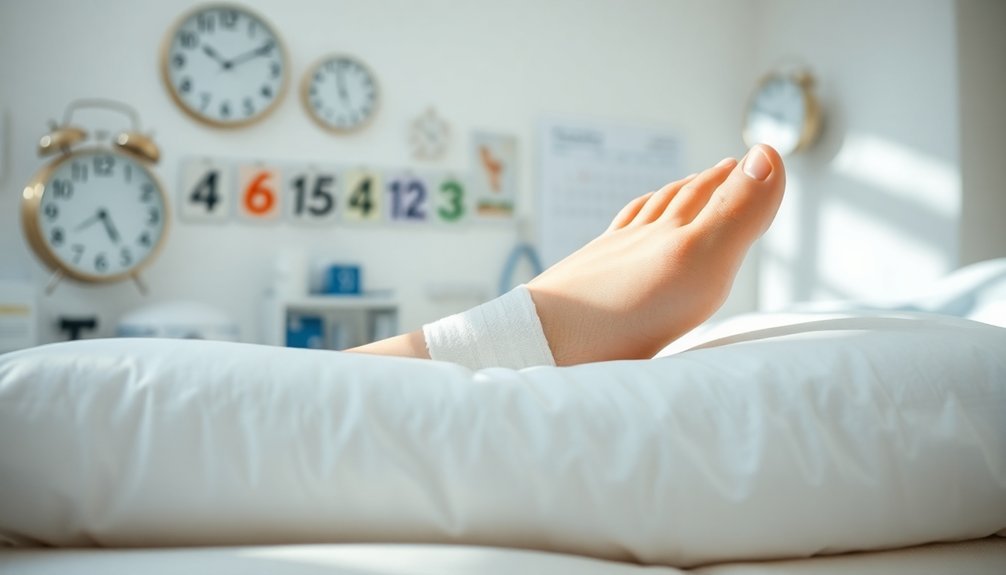
When it comes to managing diabetic sores, several factors can dramatically impact your healing process. High blood sugar levels are one of the most vital elements. Elevated glucose prevents nutrients and oxygen from energizing your cells, which can hinder your immune system's function and increase inflammation. Consequently, the delivery of essential nutrients and oxygen to the wound site becomes compromised.
Circulatory abnormalities, often resulting from peripheral artery disease, also play a substantial role. These issues lead to hypoxia and anemia in tissues surrounding wounds, decelerating the healing process. While hypoxia can normally enhance wound repair in healthy individuals, it's inhibited by hyperglycemia in diabetics. Peripheral arterial disease significantly correlates with the prevalence of diabetic foot ulcers, further complicating healing efforts.
Furthermore, neuropathy affects how your body heals. With reduced nerve function, processes like skin cell proliferation and migration are delayed, which can slow the wound's healing speed.
Lastly, the presence of growth factors is essential. Factors like PDGF-BB and VEGF can promote healing, so considering biological therapies may be beneficial.
Keep these factors in mind as you monitor your healing journey and consult with healthcare providers to optimize your recovery.
Benefits of Red Light Therapy
Red light therapy offers promising benefits for those dealing with diabetic sores by accelerating the wound healing process. This therapy boosts cell proliferation, migration, and adhesion, which are vital for effective tissue repair. By enhancing collagen production, it speeds up wound closure through the regeneration of fibroblasts and immune cells. Unlike some laser treatments, red light therapy directly stimulates repair without initial destructive steps.
One major advantage is improved microcirculation. Red light therapy stimulates the formation of tiny capillaries in the treated areas, which enhances blood circulation. This better blood flow allows for more oxygen and nutrients to reach your wounds, reducing the risk of complications such as amputation.
Additionally, red light therapy activates essential cellular functions and molecular pathways that promote healing. It improves cellular metabolism and increases energy production in cells, leading to effective pain management and reduced inflammation.
Clinical studies show that patients experience faster healing of diabetic foot ulcers with this non-invasive technique.
With its safety, comfort, and cost-effectiveness, red light therapy not only supports healing but also improves your overall quality of life, potentially preventing the recurrence of diabetic ulcers.
Recommended Therapy Durations
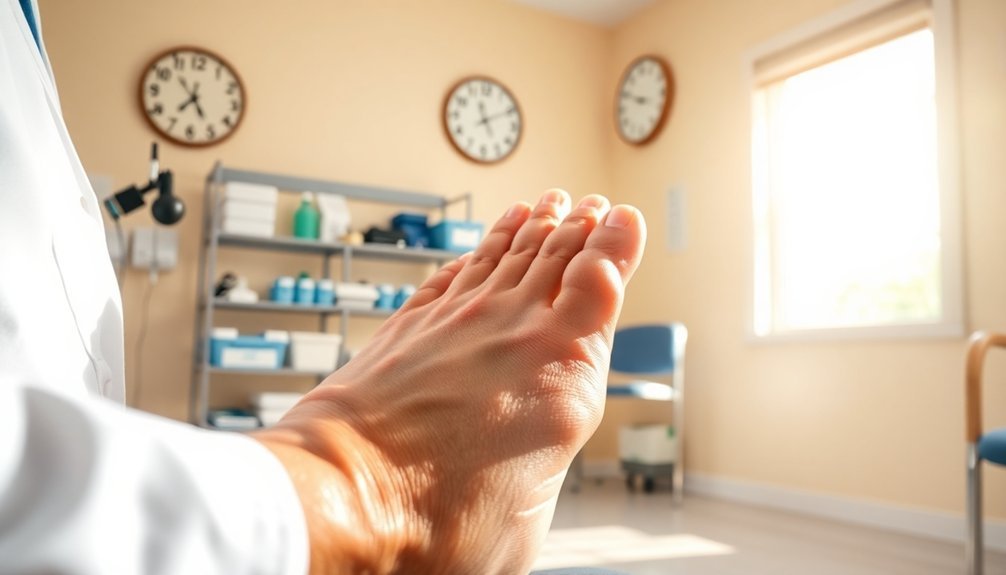
For ideal results, the duration of therapy for diabetic sores can vary considerably based on individual circumstances and chosen treatment methods.
With standard wound care, you might find that around 24% of neuropathic ulcers heal after 12 weeks. After 20 weeks, this improves slightly to about 31%. However, be aware that approximately 50% of patients fail to achieve full healing in that first 12-week period, despite optimal care. Regular debridement and appropriate bandaging play important roles in these outcomes.
If you're considering advanced therapies like Apligraf, healing can occur much faster. On average, complete healing happens in about 39 days, notably quicker than the 91 days for those receiving standard care. Most wounds treated with Apligraf heal after just one application, with the peak effects typically seen within six weeks.
No matter your treatment route, it's important to acknowledge that diabetic ulcers have a high chance of recurrence.
Advanced Wound Care Options
When managing diabetic sores, you might explore advanced wound care options like human skin equivalents that mimic natural tissue properties.
A multidisciplinary treatment approach guarantees you're getting the most effective therapies tailored to your needs.
These advanced therapies can considerably enhance healing and improve outcomes, making them a crucial part of your care strategy.
Human Skin Equivalents
Human skin equivalents serve as advanced wound care options that can greatly improve the healing process for diabetic sores.
These sophisticated products not only mimic natural skin but also enhance the body's intrinsic healing mechanisms. Their efficacy can lead to faster recovery, reduced scarring, and improved outcomes.
Here are three key types of human skin equivalents to evaluate:
- Integra: This bilayer skin equivalent promotes angiogenesis and granulation tissue formation, showing positive results for diabetic foot ulcers within 12 weeks.
- Graftjacket: A micro-ionised collagen matrix, Graftjacket greatly increases the rate of healing in diabetic lower extremity wounds, reducing both size and duration.
- Apligraf: Comprising allogenic keratinocytes on a collagen gel, Apligraf effectively fosters complete wound healing, particularly in patients suffering from venous leg ulcers.
Utilizing these human skin equivalents can optimize your treatment approach and accelerate recovery from diabetic sores.
Multidisciplinary Treatment Approach
An effective treatment plan for diabetic sores extends beyond just using advanced wound care products like human skin equivalents—it calls for a multidisciplinary approach. This strategy actively involves thorough evaluation, blood sugar control, and timely referrals. You can benefit from integrating expertise from various fields, including endocrinology, podiatry, and vascular specialists.
Here's a quick overview of critical elements in a multidisciplinary treatment approach:
| Discipline | Role in Treatment | Key Focus |
|---|---|---|
| Endocrinology | Monitor blood sugar levels | Control underlying factors for effective healing |
| Podiatry | Address foot health | Prevent complications and promote healing |
| Vascular Surgery | Improve blood flow to wounds | Reduce risk of new or recurring ulcers |
| Wound Care Nurses | Educate on proper wound care | guarantee ongoing support and care guidance |
| Telemedicine | Provide follow-up consultations | Enhance patient-provider interaction |
Involving caregivers and focusing on health education empowers patients and promotes engagement in their healing process. By staying connected through telemedicine, you can make timely adjustments to your wound care strategy, ultimately leading to better outcomes.
Advanced Therapies Benefits
Advanced wound care options offer several innovative therapies that can greatly enhance the healing process for diabetic sores. By utilizing these approaches, you can markedly improve outcomes and speed up recovery.
Here are three advanced therapies that may benefit your treatment:
- Bioengineered Skin Substitutes: These are made from living or nonliving tissue and can be placed over your wound to help accelerate healthy skin growth. They enhance the success rate of skin grafts and promote vital cellular activities like angiogenesis.
- Negative Pressure Wound Therapy (NPWT): This method involves a special dressing and suction device that draws excess fluid away from your wound. It stimulates blood flow, boosts new tissue growth, and is especially useful before and after skin grafting, increasing the likelihood of graft survival.
- Debridement and Offloading: Removing dead tissue is essential for preventing infection and promoting healing. Techniques like total contact casting relieve pressure on the wound, helping to create an ideal healing environment.
These advanced therapies can make a considerable difference in your recovery journey, so discuss them with your healthcare provider.
Role of Multidisciplinary Management

When managing diabetic sores, a multidisciplinary approach brings together various healthcare professionals to guarantee you receive thorough foot care.
This collaboration not only focuses on healing but also emphasizes preventive education strategies to reduce the risk of recurrence.
Comprehensive Foot Care
Effective management of diabetic sores hinges on a thorough foot care strategy that pulls together a multidisciplinary team of specialists. This collaborative approach is essential for preventing further complications.
Your care team may include physicians, nurses, and podiatrists, all working together to guarantee your healing process is as smooth as possible.
To enhance your foot care management, consider the following key components:
- Regular Follow-ups: You should have systematic evaluations every three months. This schedule helps in monitoring your wounds and allows for timely interventions whenever necessary.
- Utilization of Specialty Footwear: Wearing the right footwear can notably reduce pressure on existing sores, promoting healing and preventing recurrent ulcers.
- Ongoing Education and Support: Regular education on foot care practices will empower you to manage your condition better and recognize potential issues early on.
Preventive Education Strategies
A well-coordinated approach to diabetic foot care can greatly reduce the risk of complications. Your education on this subject is essential. Understanding risk factors like neuropathy, altered biomechanics, and vascular disease helps you manage your foot health better.
You'll learn important practices, including proper foot monitoring, nail and skin care, and choosing the right footwear.
Multidisciplinary teams play a significant role in your care. These teams, consisting of physicians, nurses, and podiatrists, regularly assess your foot health and provide tailored education and footwear modifications every three months.
They also focus on identifying high-risk conditions, ensuring you receive thorough evaluations of your neurological and vascular status.
Remember that annual foot examinations can help detect issues early. Make it a habit to inspect your feet daily, especially if you have neuropathy.
If you've had ulcers or amputations in the past, you'll need more frequent evaluations to maintain good foot health.
Collaborative Treatment Approaches
In diabetes management, collaborating with a multidisciplinary team is crucial for optimizing care and healing diabetic sores. This approach involves various healthcare professionals, including physicians, nurses, podiatrists, and specialists from endocrinology and vascular surgery.
By engaging a thorough team, you can greatly boost treatment outcomes and accelerate healing.
Here are three key benefits of a collaborative treatment approach:
- Improved Healing Rates: Patients treated by a multidisciplinary team experience wound healing in an average of just 42 days, compared to longer durations in standard treatment.
- Reduced Risk of Recurrence: Multidisciplinary management leads to considerably fewer ulcer recurrences (30.4% versus 58.4%), providing long-term stability and reducing the chance of amputations.
- Holistic Care: Incorporating specialists like wound care nurses and rehabilitation experts guarantees personalized treatment plans that address all aspects of diabetic foot health, from infection control to nutritional needs.
Importance of Patient Education
Understanding the importance of patient education can greatly impact your ability to manage diabetic foot sores effectively. When you learn about basic foot care, prevention strategies, and monitoring signs of complications, you put yourself in a better position to avoid severe issues. It's crucial to involve your family or caregivers in this education, ensuring they know how to help you check for problems early.
To enhance your understanding, consider the following:
| Key Topics | Importance | Action Steps |
|---|---|---|
| Daily Foot Examination | Early detection of ulcers | Inspect your feet every day |
| Proper Foot Hygiene | Prevents infections | Wash and dry your feet thoroughly |
| Appropriate Footwear | Reduces injury risk | Wear comfortable and well-fitting shoes |
| Blood Glucose Management | Minimizes complications | Monitor and manage blood sugar levels |
| Regular Check-ups | Early intervention | Schedule consistent appointments with your healthcare provider |
Regular Follow-Up Protocols
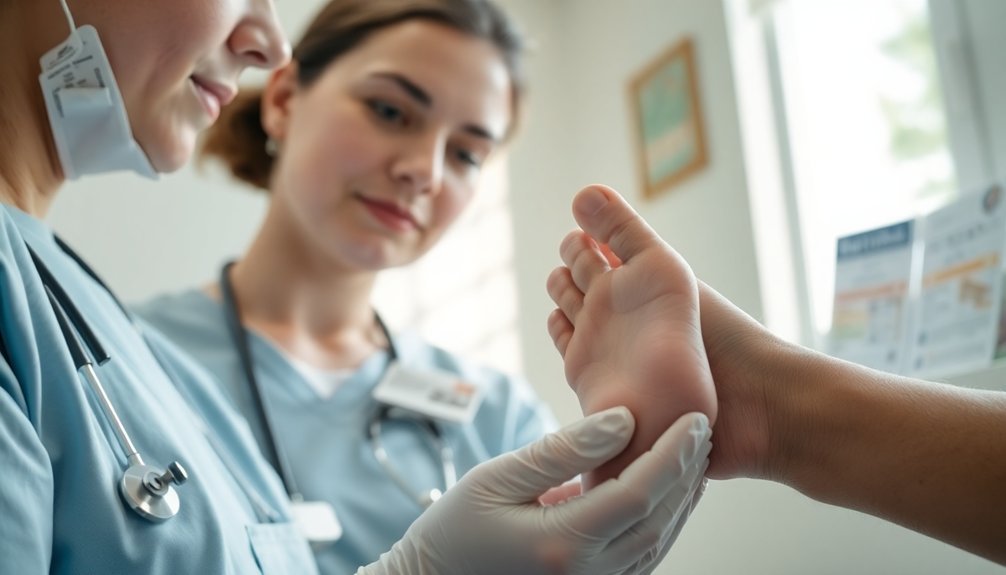
Patient education provides a strong foundation for managing diabetic foot health, but regular follow-up protocols are just as important for preventing complications. Consistent follow-up visits guarantee that any foot issues are caught early, minimizing the risk of serious ulcers or infections.
Here are three key components of your follow-up routine:
- Daily Foot Inspections: Make it a habit to examine both feet daily for any signs of blisters, cuts, or ingrown toenails. Utilize a mirror to check the bottom of your feet. Early detection can save you from larger problems.
- Regular Podiatrist Visits: Schedule routine appointments with a podiatrist who specializes in diabetic foot management. They'll assess your risk level for ulcers, provide necessary treatments, and implement preventive strategies, including tests for circulation issues.
- Multidisciplinary Approach: Engage professionals from various fields, including infectious disease specialists and vascular surgeons, if necessary. This teamwork guarantees you receive thorough care, from wound management to controlling your blood sugar levels—all essential for maintaining your foot health.
Addressing Recurrence Risks
When it comes to diabetic sores, keeping an eye on wound healing progress is essential for preventing recurrence.
You'll also need to actively educate yourself and those around you about the risks and strategies for avoiding future issues.
Monitoring Wound Healing Progress
Effective monitoring of wound healing progress is essential for preventing diabetic sore recurrences. By adopting advanced technologies and a multidisciplinary approach, you can stay on top of your wound healing and reduce the risk of future ulcers.
Here are some strategies to contemplate:
- Utilize Advanced Tools: Implement temperature monitoring devices and pressure sensors. They can help detect early signs of ulceration and decrease pressure that can lead to new sores.
- Engage in Integrated Care: Work with a care team that includes health technology professionals. Regular assessments and adaptive telemedicine plans tailored to your feedback will guarantee that your healing process is tracked effectively.
- Stay Proactive: Use therapeutic footwear and participate in foot-ankle exercise programs. Monitoring for any minor lesions is critical, as they can signal the risk of recurrence before it escalates.
Importance of Patient Education
Education plays an essential role in preventing the recurrence of diabetic sores. By understanding basic foot care and recognizing the signs and symptoms of potential issues—like loss of protective sensation or skin discoloration—you empower yourself to take control of your health.
Regular foot inspections and being aware of temperature changes can help you identify problems early and seek help promptly. You should also know whom to contact if you notice concerning changes.
Effective patient education combines oral and written formats tailored to your language and education level, using pictures and diagrams for clarity. The more you learn, the better you can manage your self-care, which can greatly lower your risk of foot ulceration and complications.
Collaborating with healthcare providers enhances this process. They need to have the knowledge to assess and manage diabetic foot ulcers effectively.
Regular checkups and a multidisciplinary approach—including resources from organizations like the American Diabetes Association—can offer thorough care. Continuous education not only reduces risks of complications but can also minimize hospital admissions, allowing you to maintain a better quality of life while preventing the reoccurrence of sores.
Recurrence Prevention Strategies
To keep diabetic sores from recurring, implementing targeted strategies is crucial for effective management.
You'll want to focus on regular monitoring, appropriate footwear, and thorough risk factor management. Here are three key strategies to help you prevent recurrence:
1. Regular Monitoring and Early Intervention**: Use an infrared skin thermometer daily to check for temperature differences in your feet. Conduct structured foot inspections** and seek immediate care for any abnormalities.
Schedule lower extremity evaluations with your physician every eight weeks to catch potential issues early.
2. Appropriate Footwear and Orthotics****: Wear properly fitting, therapeutic footwear for at least eight hours a day. Confirm regular evaluations of your shoes by a podiatrist to replace or repair them as needed.
Always avoid walking without appropriate foot protection.
3. Management of Risk Factors: Prioritize managing your glycemic control, cardiovascular health, and engage in lifestyle changes, including a healthy diet and regular exercise.
Consider foot-specific exercises and consult your healthcare provider about any necessary interventions to reduce ulcer risk.
Innovative Treatment Approaches
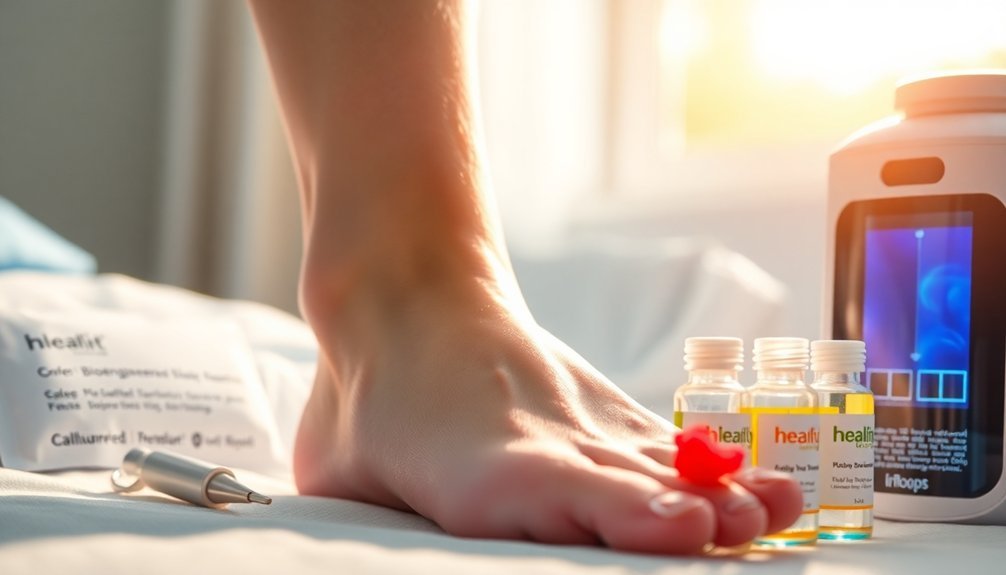
When tackling diabetic sores, innovative treatment approaches stand out for their potential to enhance healing and patient outcomes. One noteworthy development is the use of bioengineered skin, like Apligraf, which facilitates healing of diabetic foot ulcers in an average of 42 days. Impressively, 86% of wounds treated with Apligraf heal after just one or two applications.
3D printed bandages also show promise. These personalized, skin-like scaffolds release antibiotics over time, reducing the need for frequent dressing changes and minimizing infection risks. Initial results reveal encouraging antibacterial effects to support wound healing.
Additionally, stem cell therapy harnesses the power of adipose-derived stem cells (ADSCs) to support angiogenesis and manage inflammatory responses, enhancing repair processes. This method shows potential for reducing one's recovery time considerably.
Meanwhile, advancements in biological dressings, such as those incorporating recombinant growth factors, promote cellular proliferation and support healing effectively.
Always remember, sharp debridement and proper dressings play essential roles in managing diabetic foot ulcers, complemented by necessary vascular interventions for neuroischaemic wounds.
These innovative strategies could redefine how you approach treatment and improve your quality of life.
Frequently Asked Questions
How Do Diabetic Sores Differ From Other Types of Wounds?
Diabetic sores differ from other wounds because they often arise from nerve damage and reduced blood flow. Their appearance may be painless and subtle, making early detection essential to avoid severe complications and infections.
Can Lifestyle Changes Improve Healing Rates for Diabetic Ulcers?
Yes, lifestyle changes can greatly improve healing rates for diabetic ulcers. You can manage blood sugar levels, maintain a balanced diet, stay active, practice good foot hygiene, and regularly consult with your healthcare provider for best results.
What Are the Signs of a Diabetic Sore Infection?
You should watch for signs of infection in diabetic sores, like swelling, redness, warmth, pain, and discharge. Foul odors or changes in wound appearance also indicate a problem that needs prompt attention.
Are There Specific Diets That Enhance Diabetic Ulcer Healing?
Yes, you can enhance diabetic ulcer healing by consuming protein-rich foods, fruits high in Vitamin C, and maintaining a balanced carbohydrate intake. These nutrients aid tissue repair, collagen formation, and stable blood sugar levels essential for recovery.
How Important Is Foot Hygiene in Diabetic Sore Management?
Foot hygiene's essential in managing diabetic sores; it prevents infections and promotes healing. By inspecting, washing, moisturizing, and choosing proper footwear, you greatly reduce risks and help maintain your overall foot health.
In Summary
In summary, finding the ideal therapy duration for diabetic sores can greatly impact healing and recovery. By understanding healing rates and factors affecting them, you can make informed decisions about treatment. Consider the benefits of innovative methods, like red light therapy, while staying educated about your condition. Regular follow-ups are essential to prevent recurrence. Remember, staying proactive in your treatment will lead to better outcomes and a healthier future. Your journey to healing starts with the right knowledge and care.

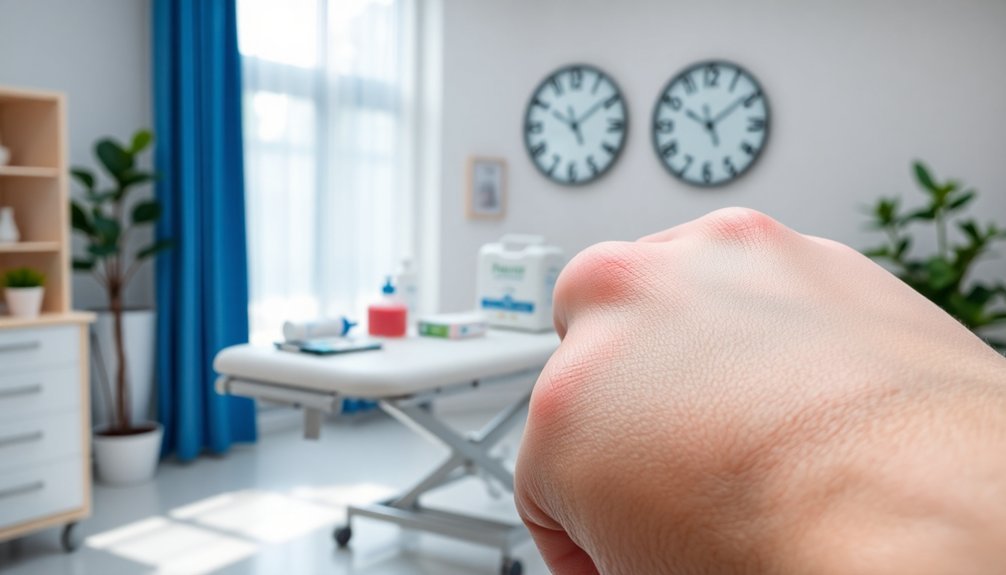



Leave a Reply